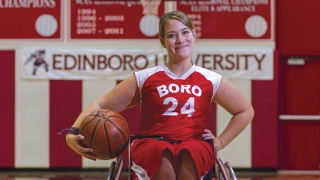An Inspiration to All
Published on
Children's ViewPublished on
Children's View Caitlin Chasar has always been very active. Throughout middle school and high school she competed nationally and internationally in swimming, track and field, table tennis and basketball. In her sophomore year, she placed first in four swimming events at an international junior world championship competition in South Africa. She was even recruited to Edinboro University to play basketball, a sport she’s been involved with since she was 10 years old.
Caitlin Chasar has always been very active. Throughout middle school and high school she competed nationally and internationally in swimming, track and field, table tennis and basketball. In her sophomore year, she placed first in four swimming events at an international junior world championship competition in South Africa. She was even recruited to Edinboro University to play basketball, a sport she’s been involved with since she was 10 years old.
These achievements are impressive, but they are especially remarkable considering Caitlin was born with spina bifida, a birth defect in which the spine does not close properly. Though she has some mobility in her legs, Caitlin uses braces to walk at home and a wheelchair when she’s out and about or playing basketball.
Caitlin was diagnosed with spina bifida at birth. Within hours, she was transferred to The Children’s Hospital of Philadelphia. Two days later, she had surgery to close the hole in her spinal cord, followed by a second surgery to prevent fluid buildup in her brain. She has been a patient of CHOP’s Spina Bifida Program ever since.
Founded 50 years ago and the first program of its kind in the world, CHOP’s Spina Bifida Program has led the way in improving outcomes for children. Back then, a child growing up to be a multisport athlete, let alone a college graduate, was unheard of; children with spina bifida weren’t expected to live long or achieve great things. But with improved understanding of the condition and better treatment strategies, these patients are now living much longer and doing things never thought possible.
“This program set the model for others to follow,” says Patrick S. Pasquariello Jr., MD, associate director, who has been with the program for 15 years. “Dr. Mary Ames, founder of the program, was a pioneer in understanding that a complex condition like spina bifida, with complex medical issues involving multiple body systems, requires a multidisciplinary clinic. All other clinics in the world are now modeled after this.”
Today, the program sees more than 500 patients and provides coordinated care for the full range of conditions associated with spina bifida, including paralysis, cognitive issues, scoliosis, irregular feet, uneven hips, and bowel and bladder problems. At a typical clinic appointment, a child can see a pediatrician who specializes in spina bifida, several nurses, a physical therapist, a social worker, a neurosurgeon, an orthopedic surgeon and a urologist, all in the same day.
Nurse coordinator Jeanne Melchionni, RN, has seen Caitlin and her family through it all, even beyond the clinic, helping with the transition from high school to college.
“She’s watched me grow up and has always provided resources to help improve my life,” says Caitlin, who says Melchionni helped her get hand controls for her car and apply for college scholarships.
“We wouldn’t be where we are today without the leadership, guidance and support we received from the spina bifida team at CHOP — most especially Jeanne,” adds Caitlin’s mom. “She always promoted Caitlin’s independence and is a fierce advocate for children with spina bifida.”
Walking is an important milestone for all kids, including those with spina bifida. For Caitlin, it has been a journey. Physical therapy to help her walk started when she was just a newborn. At home on a daily basis, her parents helped her do range-of-motion and positioning exercises. At 1 year old, Caitlin was fitted with braces and taught to walk with a walker first, then crutches.
At her care team’s encouragement, she got involved in activities to help develop upper body strength, including swimming, horseback riding and wheelchair basketball, which requires the challenging task of dribbling the ball with one hand while moving the wheelchair with the other.
“My mom says when I was a baby I used to sweat so much because I would be putting so much effort into walking,” Caitlin says. “It hasn’t always been easy but pushing me as far as I can go is the reason why I am independent and healthy today.”
That health and independence has been an inspiration not only to Melchionni and the program’s team, but also to other parents.
“As I got older, I would see the next generation of babies in the waiting room for clinic,” Caitlin says. “I would visit with them and their parents, and I think it was really uplifting for them to see someone older, doing well.”
Caitlin’s experiences with spina bifida and the care modeled by her CHOP team over the course of her life have inspired her to study vocational rehabilitation and pursue a career helping others with disabilities reach their full potential. Now 23, she is in her second semester of graduate school.
“I feel like I’ve been given a lot,” she says. “I’m very thankful, and I just want to give back.”
— Abny Santicola